DRAWinternational in Caylus, France
I recently undertook a residency at DRAWinternational in Caylus, France. I was in the studio for eight weeks, over which I developed a body of work that will inform my PhD thesis. The residency culminated in an open studio exhibition through the seven rooms of the space. The open studio was presented with this statement:
During my time in the studios at drawInternational I have been undertaking practical and theoretical work towards my PhD. The thesis is concerned with phenomenological embodiment, mimetic representation, and the body as extended through tools, materials, and spaces.
My work here has focused on investigations into how the shape of the body along with the tools and apparatus of the studio facilitate, extend and limit processes of mimetic representation. Most importantly, my practice conceptualises mimetic process not as the the construction of an accurate optical likeness, but the intermodal (or multi-sensory) means by which we make sense of our being-in-the-world through attentive, active, reflective and reiterative exploration:
Mimetic skill or mimesis rests on the ability to produce conscious, self-initiated, representational acts that are intentional but not linguistic… Mimesis is fundamentally different from mimicry in that it involved invention of intentional representations.
-Frank R Wilson, 1998, The Hand p48
The marks of these drawings are made in sensorial referral to tactility, proprioception (or kinaesthesia), sound, and occasionally vision. In this sense the drawings are observations translated from the interconnected array of senses through gesture into a visual format. In the words of Francis Bacon, these drawings aim to “come across directly onto the nervous system.” (Francis Bacon quoted in The Logic of Sensation, 1981, Giles Deleuze, p32) However rather than being prescriptive of how works are to be viewed I consider this as terms that describe the process and event of the work. The work is a transcriptive element of a conversation between the expansive array of contributing elements: the body, materials, tools, ground, studio space, studio furniture, traditions of drawing, cultural and social context, the audience, and so on.
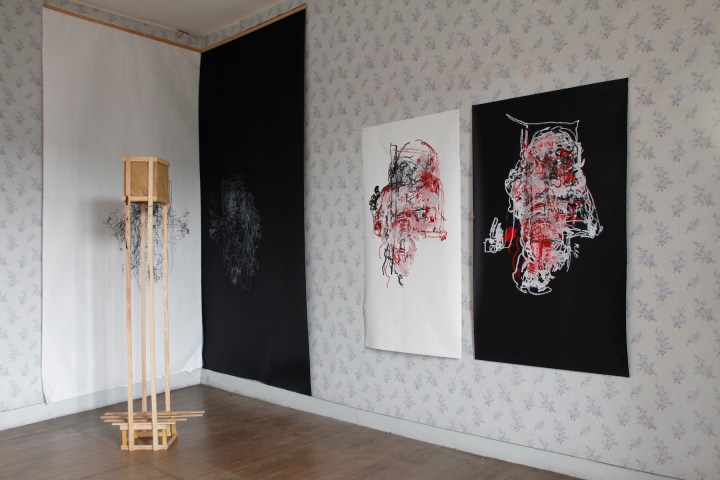
Over the course of the residency I constructed studio furniture objects that were used in the production of drawings. They were built to restrict movement and obscure vision during the drawing process, their form influencing the shape of the drawings. I also expanded my materials to include oilstick, which records a different buildup of information than pencil and charcoal.
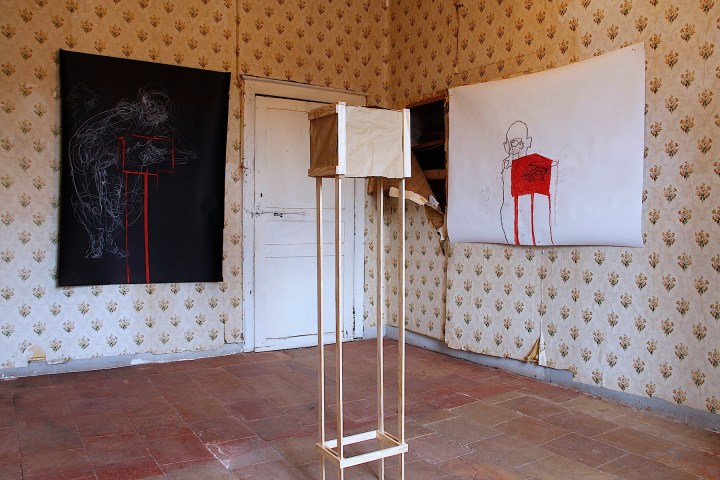

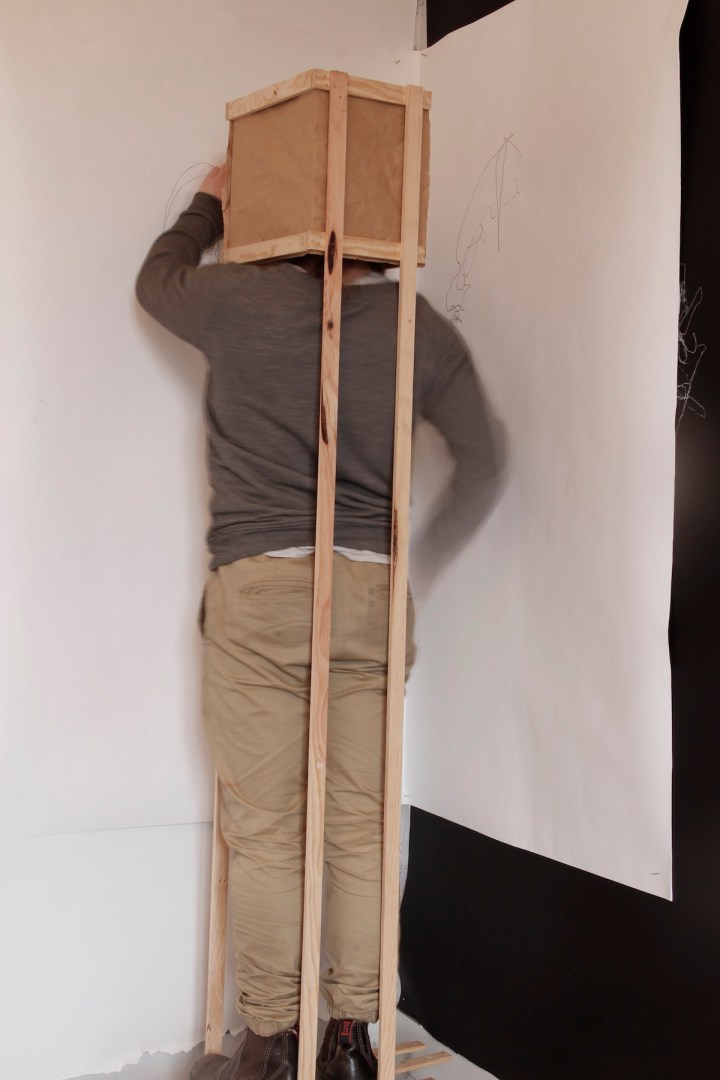


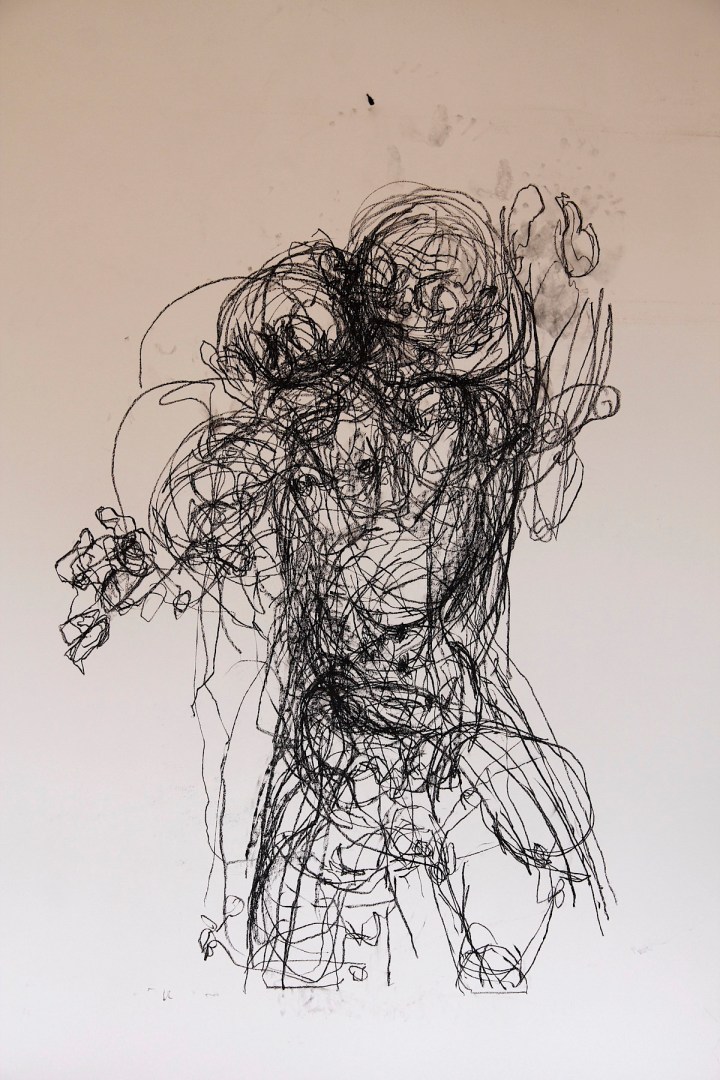

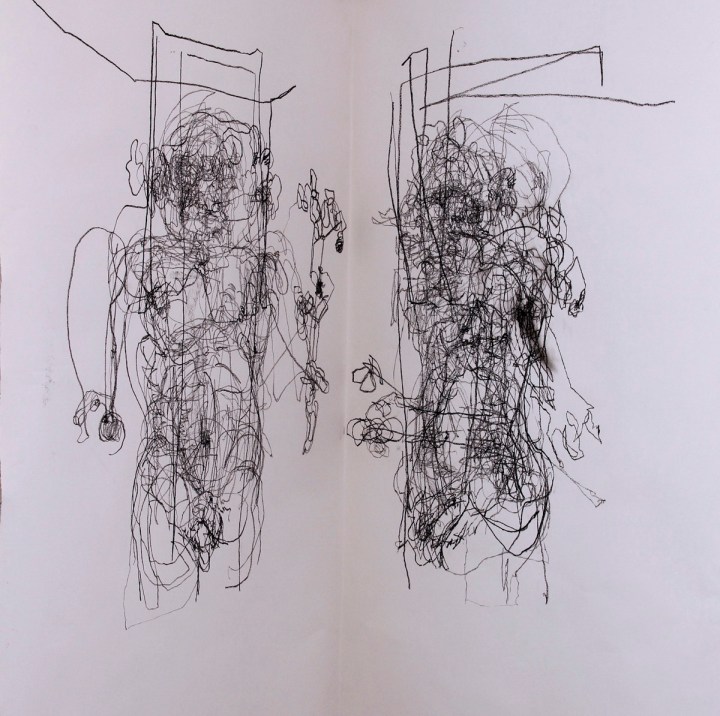
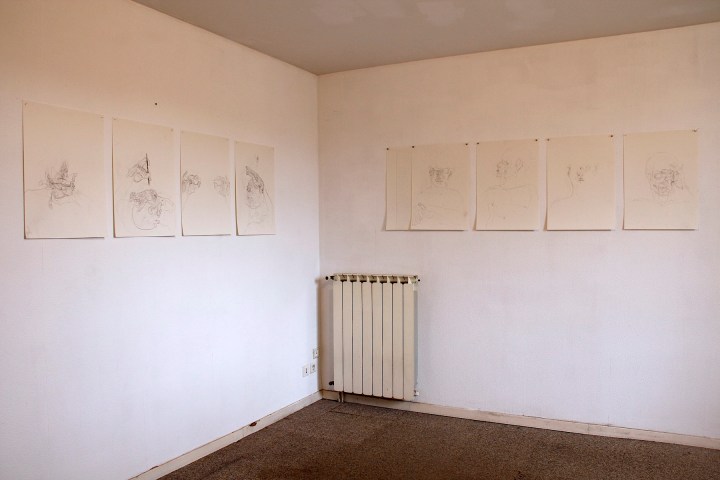




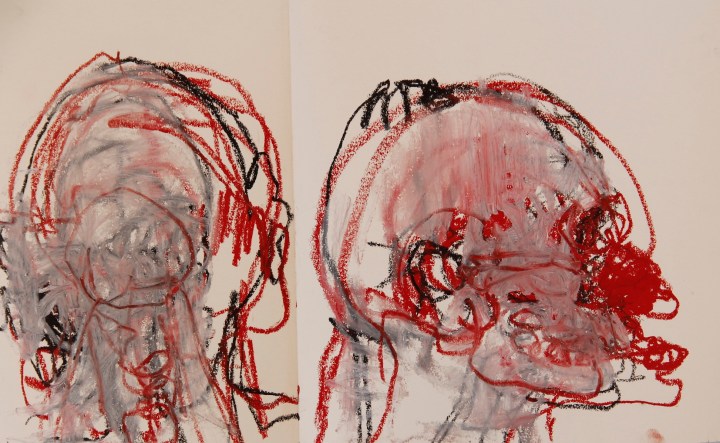





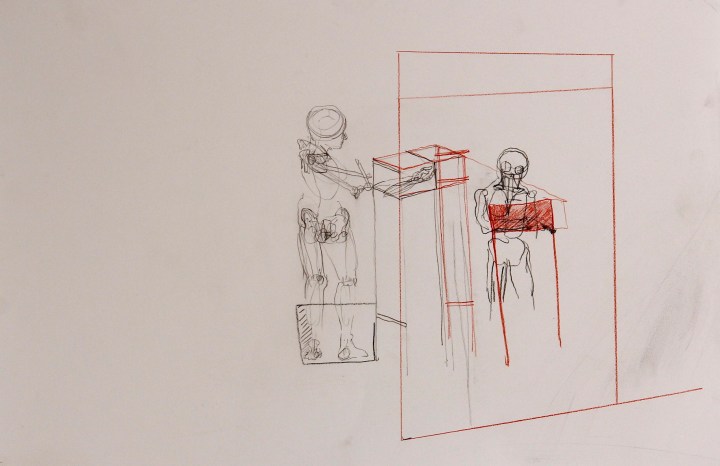


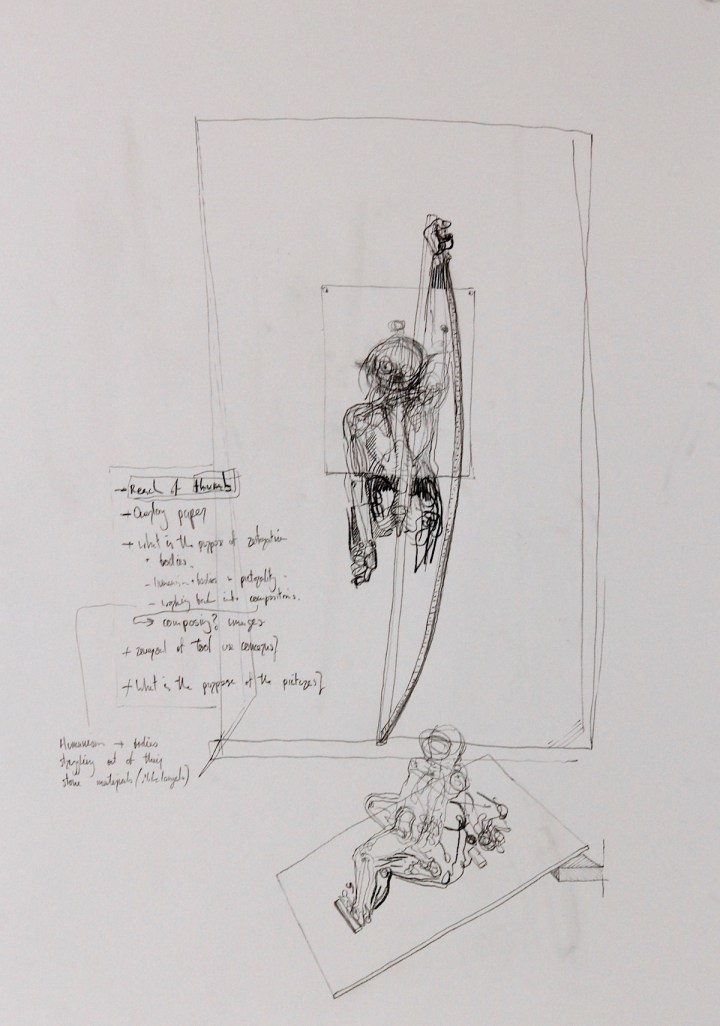

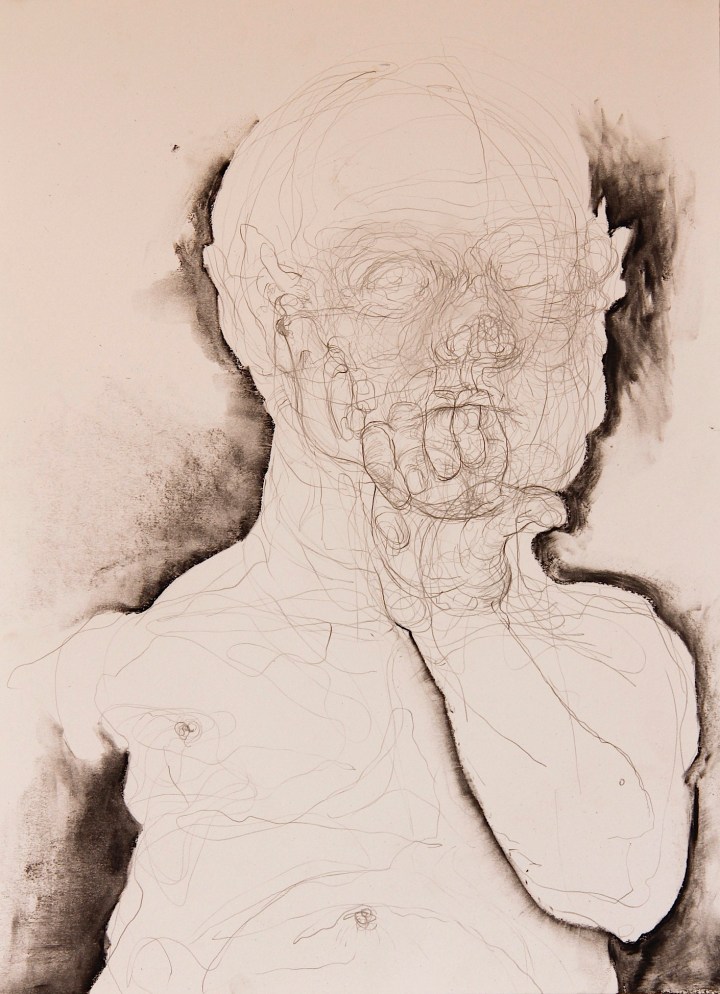


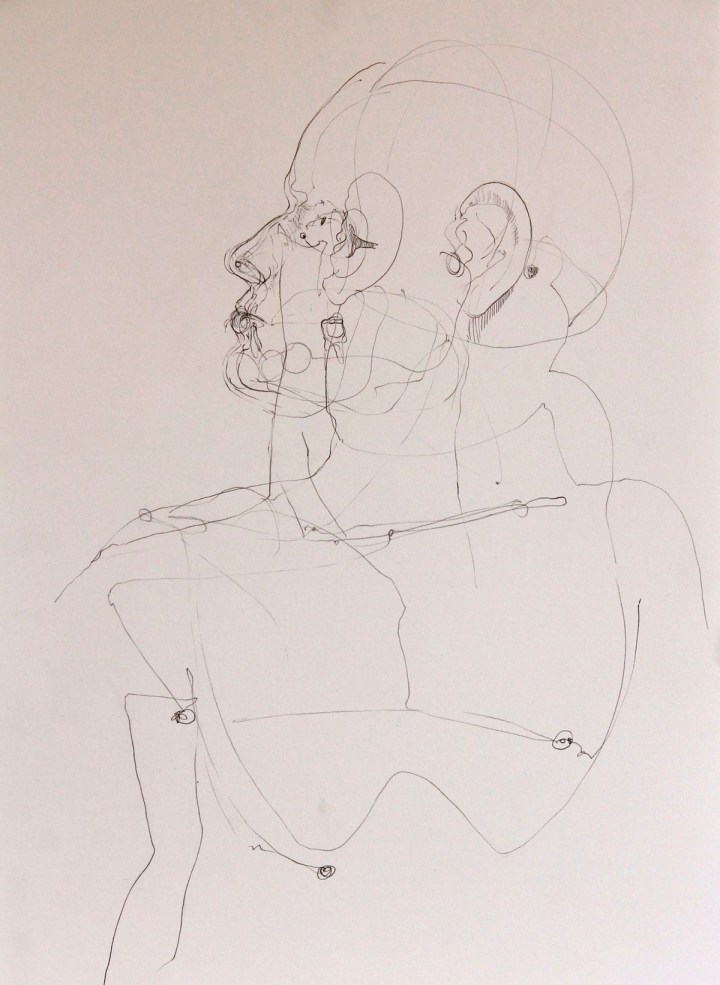

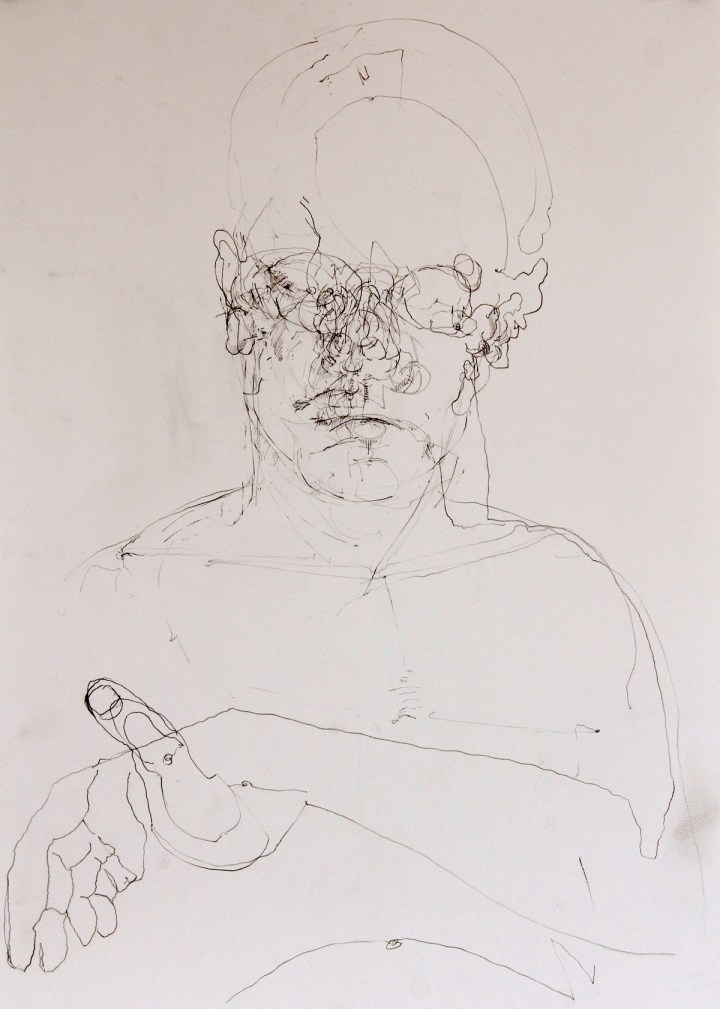

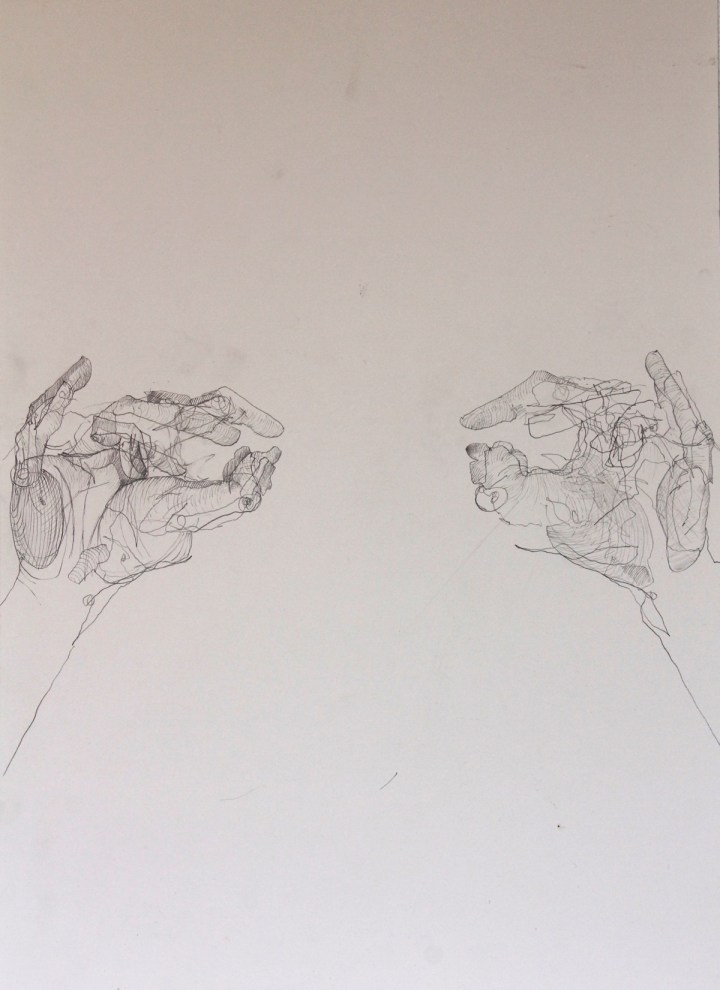
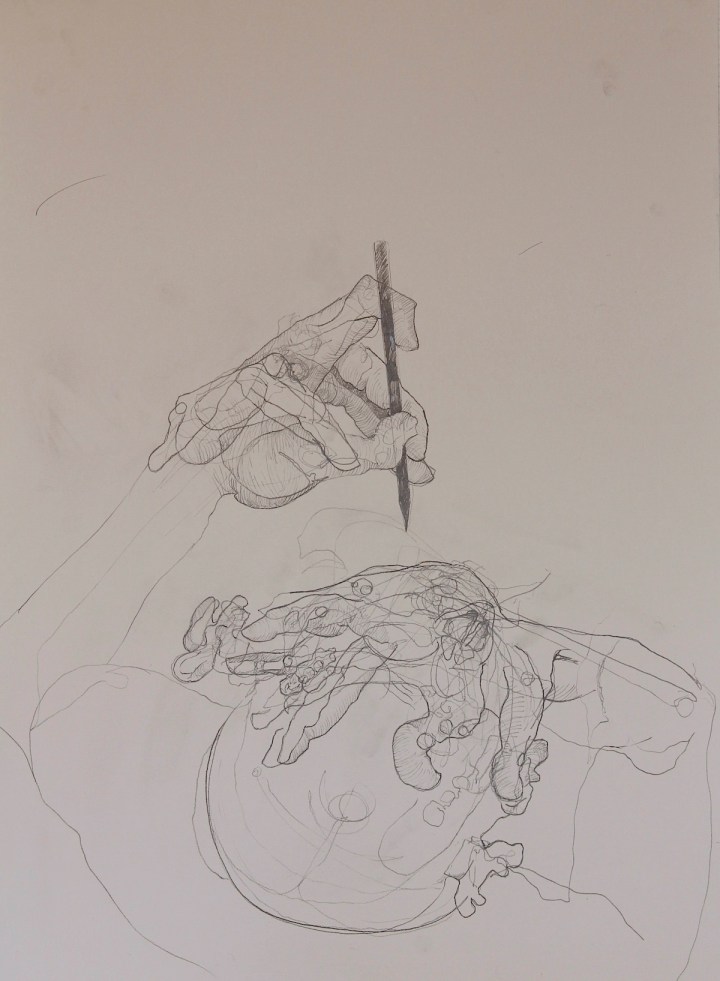
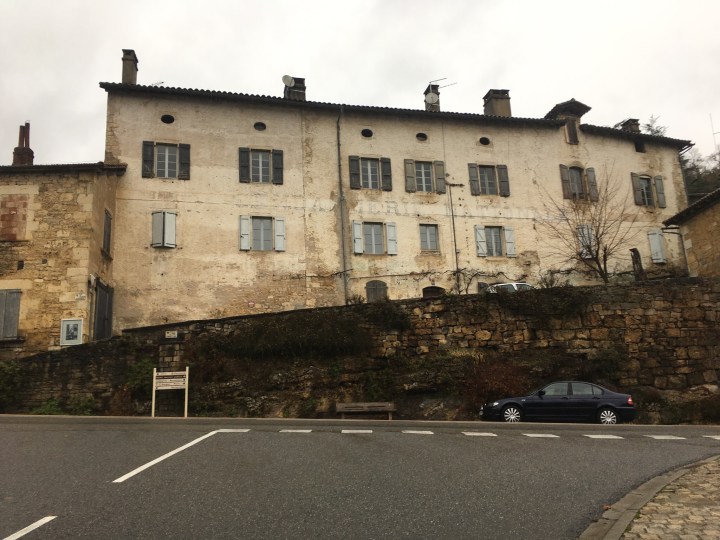
The studio.
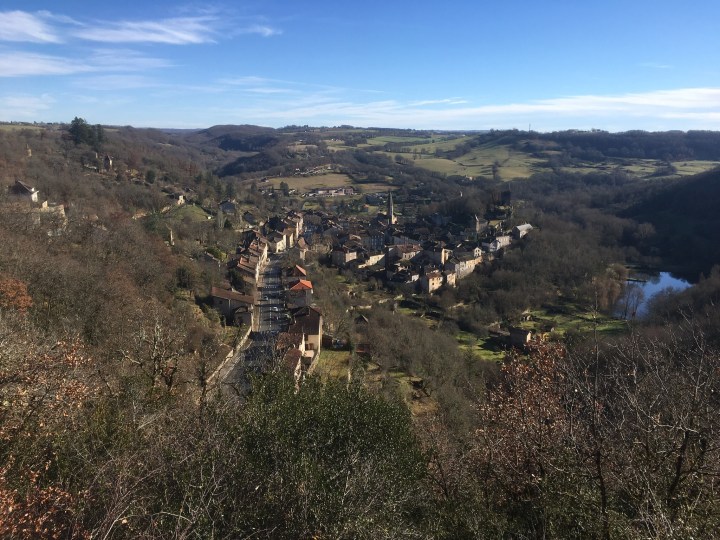
The town of Caylus.

The goats that lived up behind the studio.

Language and Thinking
The Body and its Objects
The following drawings are the ongoing continuation of my explorations in mapping out my body through proprioceptive, simulated, remembered and mimetic means.

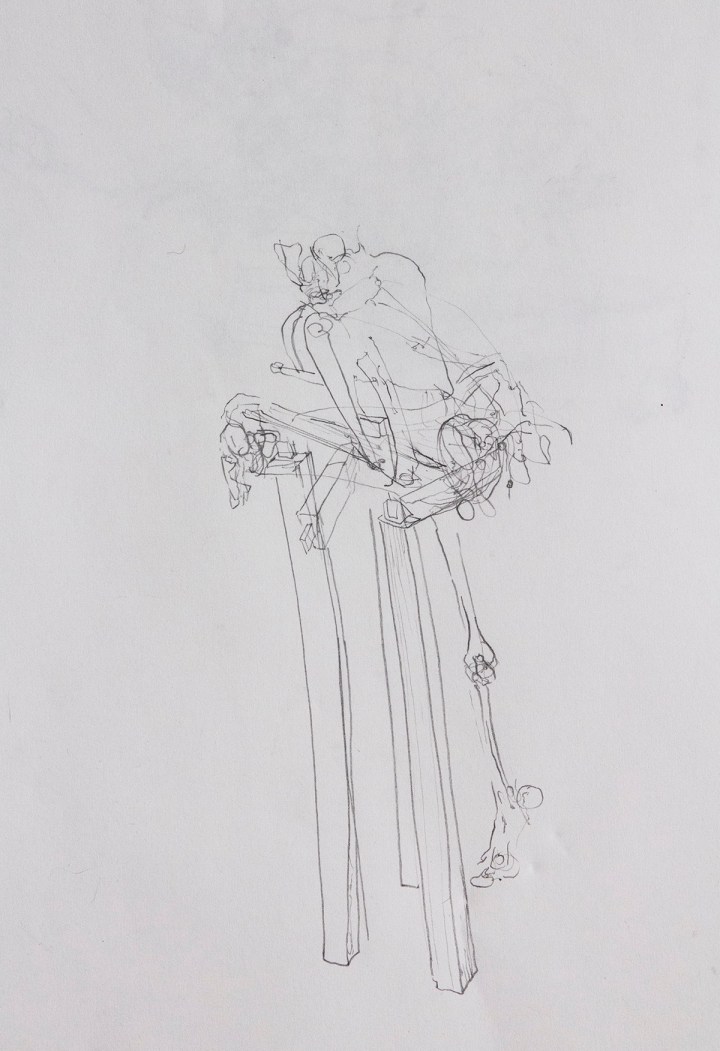




I have continued to produce self portraits through largely non-visual means, and I find the reflective and reiterative process continues to change over time. The two drawing above were done on different occasions without reference to one another, I am unsure which one was first, however they were both done in the same bodily position with the same spatial relationship between the drawing surface and my body. I find the similarities in these drawings done under the same conditions particularly compelling, not so much in their overall similarity, rather in the similarity of the constellations of description and the repeated use of points of reference— the corners of the nose and mouth, collarbones, the sternum, the brow. In the thinking act of mark making I have become less concerned with the pictorial content of the image and have directed my attention to the location of marks in relation to previously established landmarks. This can take several forms, in the most conventional form I may occasionally peek at the drawing to confirm that I am starting a line where I believe it should go in spatial relationship to the existing landmarks, say, up and to the right of the corner of my mouth. Alternatively if I am truly drawing blind I have my internally simulated expectation and memory of where the same point would be, and an embodied understanding of where that point is. Of course, this method is not necessarily accurate in a conventional pictorial sense. Finally, I can leave physical way points to return to using touch, so that I can find my way back to a point and continue drawing with a greater confidence that the marks I make correlate in a meaningful way to both the proprioceptive observations of my body and to to the information carrying marks already on the drawing surface. Doing this produces a drawing that begins to maintain pictorial consistency and readability as a map of the body while also moving away from the perspectival and visual trappings of image making. This is a point that has become a particularly interest in my current thinking, that is, how limited to the visual are pictorial means of image making, particularly with concern to line? It seems that the making of lines can serve as a meaningful tool for assessing and articulating perceptual information without necessarily being accessed through a visual framework.
Gestural Thinking
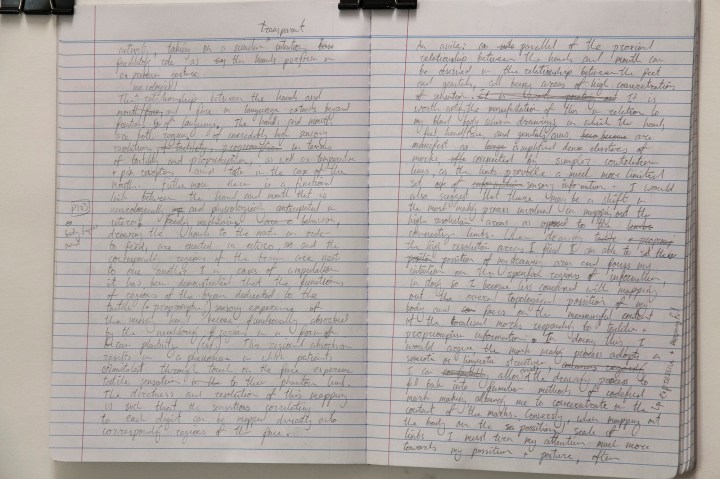
A further aspect of my research has led me to looking into concepts concerning the relationship between gesture, thought, and language. Through these concepts (outlined by David McNeal in Gesture and Thought, and Shaun Gallagher in How the Body Shapes the Mind) language can be thought of as far broader than verbal, and that the thinking processes that generate language are dynamic and reflective, in that our intended communications are not pre-formed in the brain and merely delivered orally or textually, rather, gestural processes help form thought and meaning. Furthermore, both verbal and textual communication can be considered a
So while drawing doesn’t necessarily have the same codefied structured conventions as written or spoken languages, it does form a language in the sense that it is an internal/external structuring and mapping of the world and a process of meaning making.
In the sense of depictions of the body and objects there is a certain extent to which a rudimentary language of representation can be said to exist, and certainly in my practice, as with many people, I have developed a particular language and style in representing the body. The capacity to use drawings of simulated events and objects is not simply recording an idea for a work, it is a means to think out the work, to articulate and consider what something might be. I have previously described such drawings as propositional, and in relation to my drawing practice they are often used as a “what if” device: what if I set up X conditions for a drawing? What would the experience of being in that scenario be? How would it appear to an audience? What would the resulting constellation of marks and objects look like? What meaning might be embedded in such an action?

An example: a plan for a drawing in which I make a barrel and corresponding deck, from within the barrel I could consider myself a different kind of perceptual being—a blind cylinder with a single limb. I would have the capacity to roll in either direction and map out my proprioceptive understanding my my body’s shape and position within the barrel. The capacity for this mapping of the event would be limited by how far I could reach, the roll of the barrel, fatigue, and so on.
Political Noise + The Anthropocene
Beyond the immediate conditions of the drawing there are also a great deal of other connotations and implications in the use of the barrel, many of which reveal themselves as the idea unfolds. Of particular note are the darker tones of the contemporary and historical use of confined spaces and sensory deprivation as a torture device. In parallel to this is the personal narrative of negotiating the current climate in which I am making art, under the current environmental, cultural and political conditions that are running at fever pitch and are seemingly impossible to process, let alone address. This has become an undeniable theme in the work, and I will continue to expand on it as the projects progress. In view of this it is also worth noting the impact that music has on my thinking, in this instance I cannot help but reiterate a line from The Drones’ Sharkfin Blues: “I float away on a barrel of pain/it looks like nothing but the sea and sky remain”. I find The Drones’song writer Garreth Liddiard’s musings on the apocalyptic feeling of the current climate resonate particularly strongly with much of my thinking and I find I borrow many refrains in my work.
A further example of similar process is seen below, I have been thinking about constructing structures for a while now, with an interest in the role spaces have in the conditions of making drawings, but also more broadly. I am particularly interested in the Australian vernacular of timber slab huts and tin sheds, and the way these structures come from particular environmental, cultural, and political conditions, operating variously as a locus for colonialism, the westernized and localized personal work shed or industrial wool shed, and as a communal entertainment venue.
The drawings below were done shortly after a large storm in Sydney that coincided with a heatwave, the first few weeks of Trump’s presidency, and the continued insistence of the Australian government that the continued burning of coal is a good idea. At the time of this storm I was in the workshop shed at my residence in Belmore, the sound of the rain on the corrugated sheet roof was the same deafening roar as I occasionally experienced growing up. I have always enjoyed big storms and find them to be very exciting. The noise of the rain allowed me to make as much noise as I wanted late at night without disturbing the neighbours, I became excited at the idea of hearing a band play in such a space. The heavy rain also always has the effect of putting the song Tupelo by Nick Cave and the Bad Seeds in my head, itself an apocalyptic account of an endless storm that wipes away a town.
The coalescence of these events coupled with my anxiety and defeatism led me to consider the ideal space to sit and watch the apocalyptic environmental/political tropical fuckstorm roll in (Tropical Fuckstorm Records was founded by the Drones in 2015). Key to the structure would be the iconic corrugated iron roof, that amplifies heavy rain to a deafening thunder, so I imagined the space as part observation deck, part instrument resonator box, like an acoustic guitar or steel drum.

Back To The Workshop
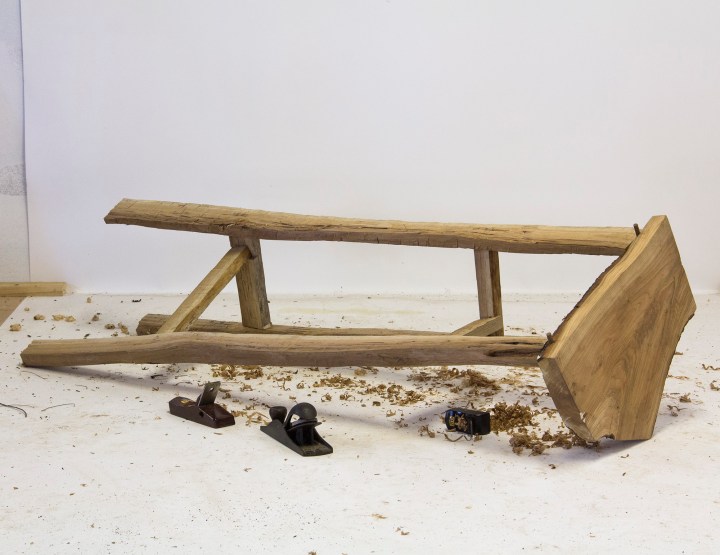
In the workshop I have been thinking about the wrangling and anthropomorphizing of furniture objects as I continue to work on them. One of the drawings at the beginning of this post was done after starting to shave down the legs of this stool, a slow process of removing material. In woodworking terms this is an unconventional approach, however I find the way it forces me to rearrange my body around the stool to brace it and work it particularly interesting, working this way can take various forms, from slow and considered to focused and vigorous, or exhausting and frustrating. This process is still in a formative stage, I intend to expand it through new pieces that have particular impacts on the relational positions between the bodies at play.

While in Melbourne recently I picked up a piece of plantation paulownia timber to experiment with as a structural and sculptural material and a drawing surface. My intention is that a cheap, light, and consistent source of wood that can function in the role of studio furniture drawing surface. With this I can draw on the wood and then plane it back to reveal a fresh surface, I also have the hope that with practice, patience, and very careful work it might be possible to take of consistent and regular shavings that retain the drawn marks and can be pieced back together to recreate the image.
Paulownia timber has an interesting history in Australia and globally, I intend to expand upon this soon.

A language of offcuts. I have been collecting all of my offcuts and an array of discarded timber, firewood, and bits of felled local urban trees. I find there there is a particular taxonomy of the bits and pieces I am collecting, some I find uses for, others I grow attached to and cannot commit to working. I have plans to begin to make object assemblages out of the various pieces that continue to explore the relationship between drawing, object, body, and furniture.


I have also altered the surfboard, after its first outing I discovered it was to narrow to be stable, although it worked incredibly well as a body board, which was a lot of fun. I ripped the board in half and inserted a piece of what I believe to be meranti timber, and inserted some butterfly keys to fix a crack that had appeared and to hold the structure together. I took it out again last week and was still unable to stand up, however I am confident that this is starting to be more a matter of my lack of skill and trepidation than the proportions of the board. I will hopefully be able to find someone to work with in the water who might be able to give me some direction as well as bring their own experience to the board. I will also be making another board our of the above mentioned paulownia, which is supposedly an ideal timber for alaia boards.
Kim’s Dirt

Finally, I have become more mindful of the waste that I produce in working, although I recognize that at this scale it has negligible environmental impact it serves as a further consideration point of my practice and agency in the world. I have begun to compost the shavings and other waste I produce when working, and have become strangely invested in and excited about the dirt I am producing. I have also found gardening to be a particularly relaxing foil to the more intense labour of the workshop and writing desk. While making dirt is easy it takes a long time, and is largely a matter of allowing natural elements to do their thing. Making dirt is an ongoing project, and should I have to relocate anytime soon due to the instability of Sydney housing (yet another anxiety of the Australian psyche) I intend to take my dirt with me.
Studio-apparatus-workshop-furniture
Since my confirmation a few weeks ago I have been playing around in the studio and workshop. The work has continued to focus on the phenomenological material intersections between myself, the workshop-studio, tools and materials, and the expanded environment.
These two drawings are full body scale mappings of my body and the studio-setup of drawings surfaces and studio-furniture. They serve as records of the interactions between the contributing elements as they facilitate and interrupt my actions of intentionally mapping out the perceptual experience of sitting, drawing, and being.




By drawing upside down I am playing with interrupting the conventional ergonomics of drawing, an element that is so familiar to drawing that it recedes into the background and is rarely considered as an active element of process. In these drawings I hope to bring environmental factors like gravity, the body interrupting itself, and the relative position of the drawing surface back to the foreground, so that they become active elements that contribute to the activity of drawing. As I engage with and become familiar with these processes and assess the influence they have on the emergent drawings I begin to accomodate or acclimatise to their influence. This circular and recursive quality makes it difficult to assess such elements in their fresh uninterrupted and unassisted state— as the process of their discovery reveals the properties that may prove interesting to assess as accessed through limited perceptual experience— any artificial limitations of perception (such as blindfolds) are immediately negated as soon as the manifest drawing is assessed. Furthermore, the familiarity with how intentional actions create image-lines will forever influence how intentional lines are made in the future.
An example: I have attempted to draw my head as projected onto a surface behind me before, I know that if I move the drawing stick ‘like-so’ recognisable marks will be laid down. I no longer need to assess and re-assess the marks as compared to the source sensation to confirm their representational accuracy or capacity, as my familiarity with depicting noses and nostrils etc gives me the confidence to lay down the marks without second guessing their accuracy. It is worth noting here that I spend a lot of time drawing my nose, nostrils, and inner nose-throat-sinus-cavity as I experience them from sensations of proprioception, locatable internal itchiness, tongue probing and so on. I find that there is such a concentration of sensation in my head, sinus, hands, feet, and genitals that I amplify the representational gestures that record the experience of embodied being, the record becomes a homunculus of perceptual experience.
These drawing below are a smaller scale, each drawing is on an A2 sheet of paper. I have been experimenting with proprioceptive drawing from external viewpoints, imagined or simulated body positions, and projecting myself into positional relationships with objects. The first two drawings are done while sitting at my desk with the drawing pad in my lap, a position I spend a lot of time in, I find that if I don’t make a conscious effort to select an external viewpoint I project my body onto the paper through a trajectory in line with my head, however there seems to be no ‘front’ or ‘back’ to the manifest representation, in being flattened it takes a form that can be read as concave or convex.

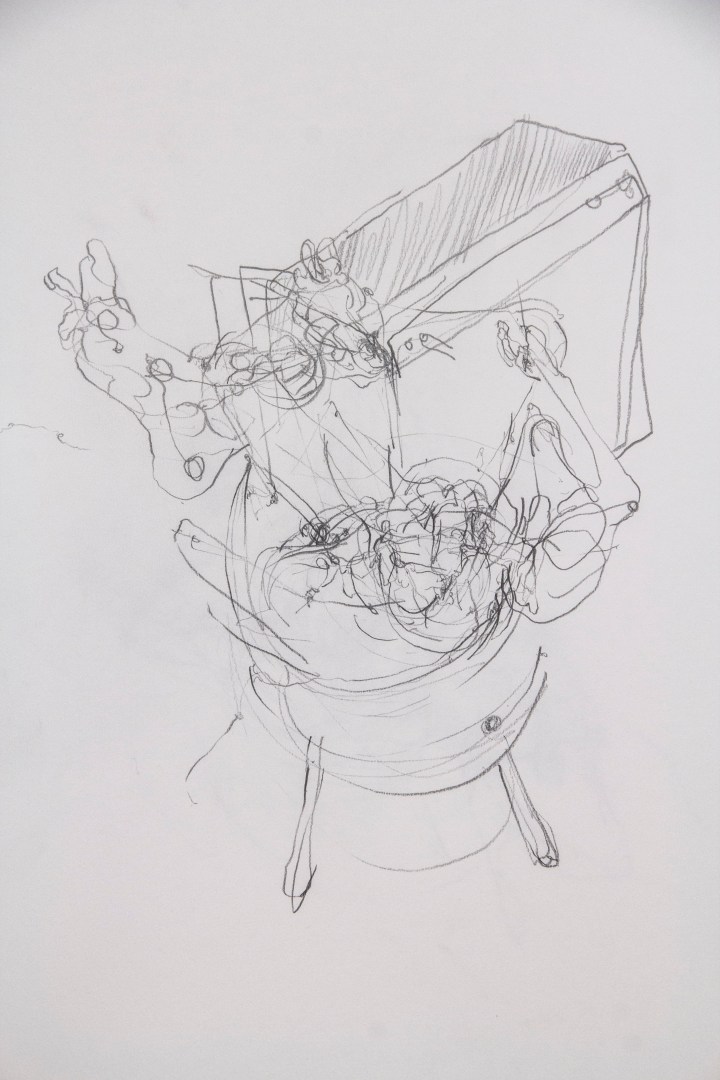
These drawings where done before the stool was complete, I had climbed on the frame but not mounted it or perched on it.
As I was drawing these I was looking at the incomplete stool with the seat slab balanced on the frame. I imagined/projected myself into the position as influenced by my attempts to climb the frame before the seat was attached.


—
This drawing is a sketch of a planned piece of studio furniture, a small box on legs. I intend to to use the box in a similar manner to the other pieces of studio furniture, allowing the difficulty of balancing on the tiny object to impact the process of drawing.

—


I have also just finished this piece of studio furniture, an impractically high surface to sit on. I will be starting a drawing using this stool soon, the height will again disrupt the comfortable ergonomics of drawing.


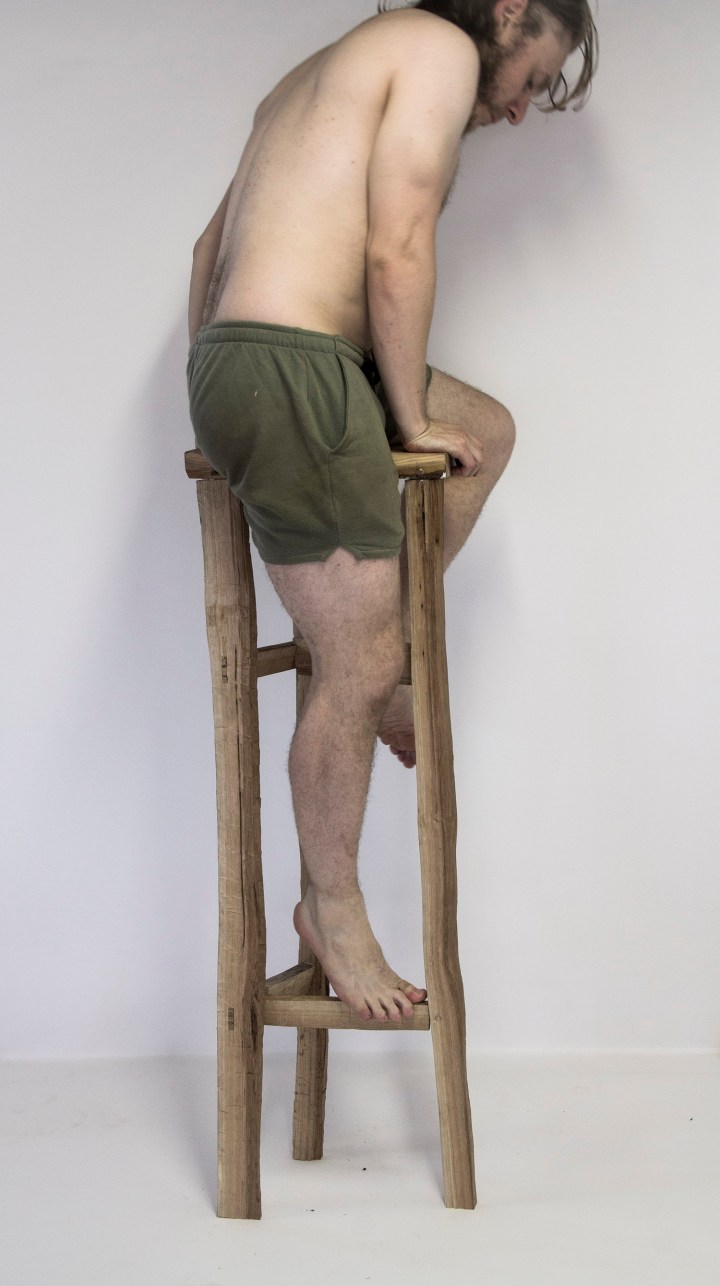
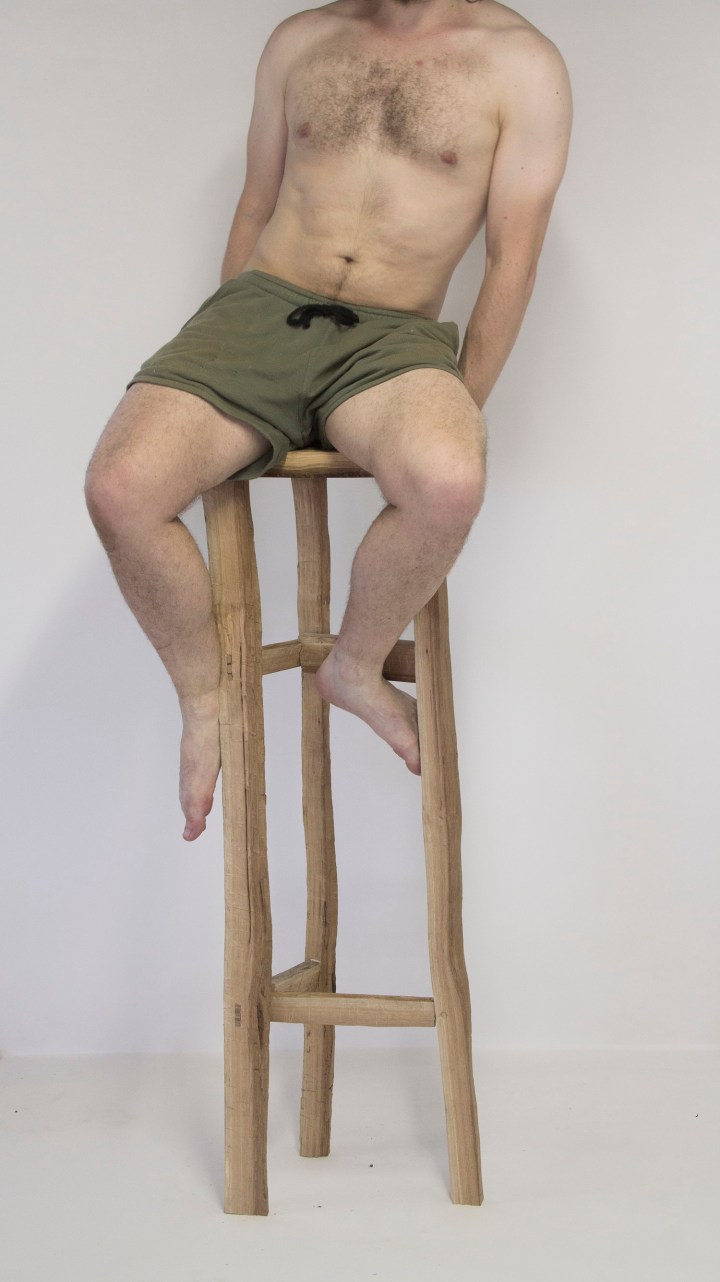
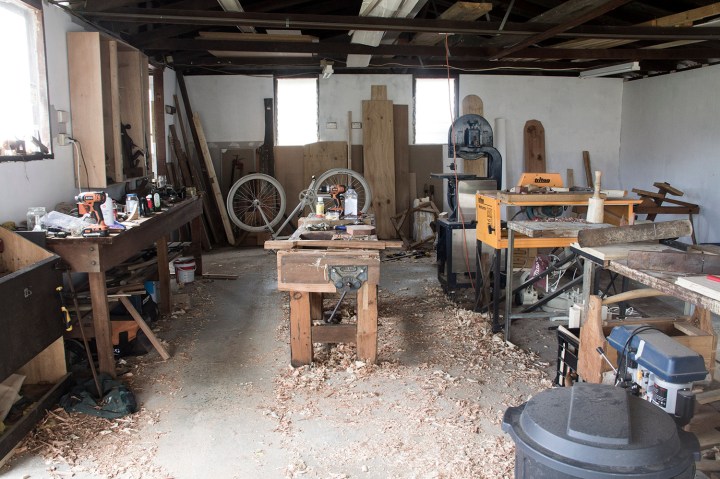


These are my first attempts at carving alaia surfboards, I am not a strong surfer and haven’t done it for a few years, but I was recently introduced to the work of Tom Wegener (http://www.tomwegenersurfboards.com/about-tom-0) and got really excited about shaping a simple surfboard from a piece of wood. I’ll have a chance to try them out in a few weeks, we’ll see how it goes!
Big Drawing
Last week I presented my confirmation paper at the UNSWAD Post Grad Conference, it was deemed satisfactory so I am now officially a PhD candidate on track to graduate around 2019. The paper outlined the work I’ve been making over the last 8 months, and some of the work was on display in the accompanying conference exhibition. This work serves as propositional pieces for what I will be doing over the next few years, so the ideas presented here will be expanded, experimented with, and refined before being presented as a part of my final thesis.


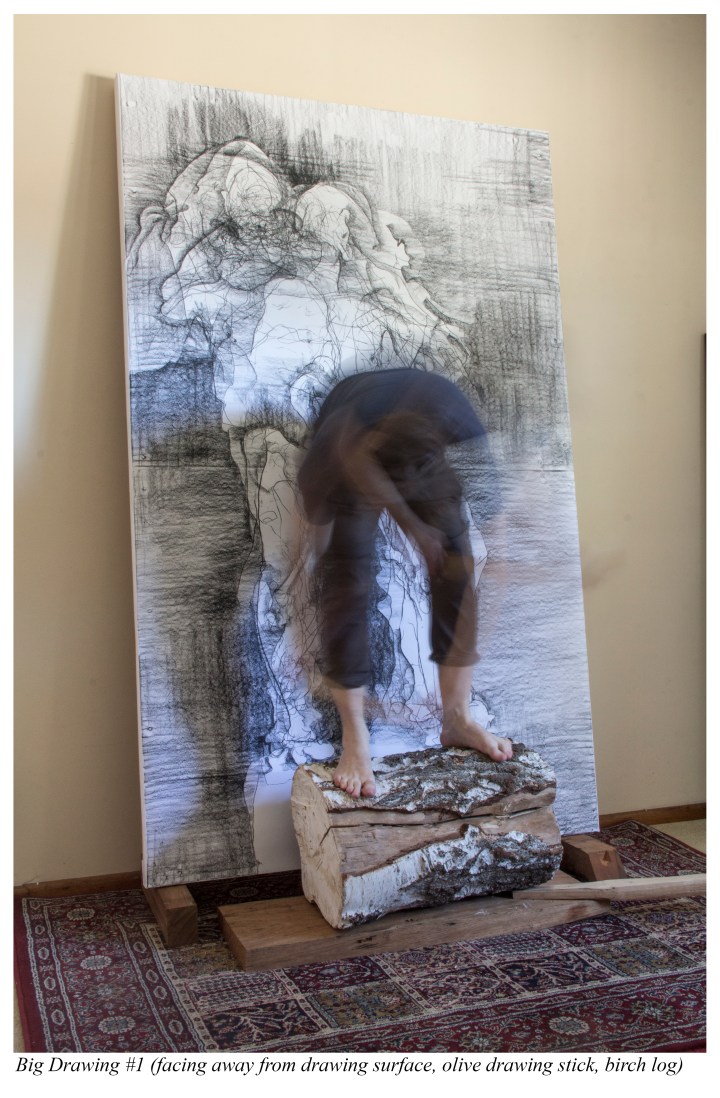




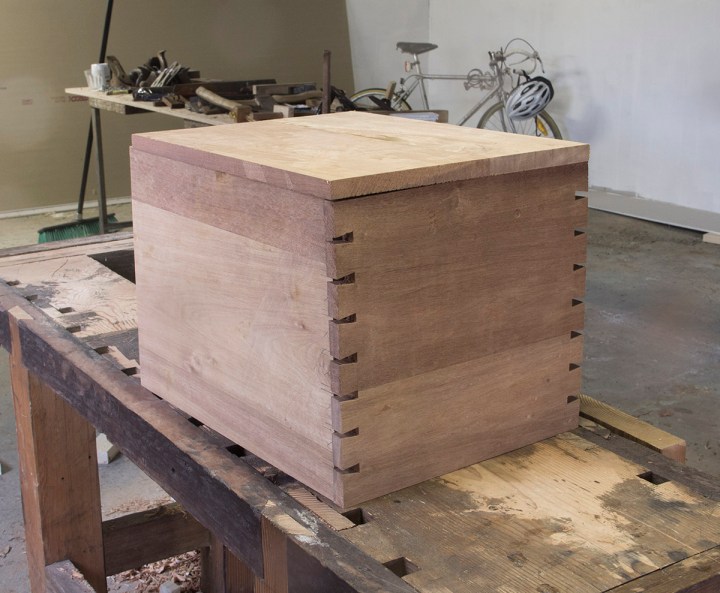





Studio-Workshop
I’ve been putting a lot of time into the garage, attempting to turn it into a proper workshop-studio. It’s a bit chaotic at the moment but once the walls are finished I should be able to clear it out and set it up nicely. It should give me somewhere to start working on some larger works that I am planning. Once the walls are done I’m planning on doing something about the lighting, the floor, and storage. This is hopefully going to be the space I work in for the rest of my PhD, so I want it to be as practical and comfortable to work in as I can manage.
 My vast pile of tools in the centre of the room, and the general chaos of perpetual attempts of planning, structuring, organising, and building my space.
My vast pile of tools in the centre of the room, and the general chaos of perpetual attempts of planning, structuring, organising, and building my space.
 The second room out the back has even more stuff stored in it. It is a nice little room with a lot of light, but it’s going to be a while before I get to it.
The second room out the back has even more stuff stored in it. It is a nice little room with a lot of light, but it’s going to be a while before I get to it.
 All of my benches waiting outside the studio-workshop.
All of my benches waiting outside the studio-workshop.
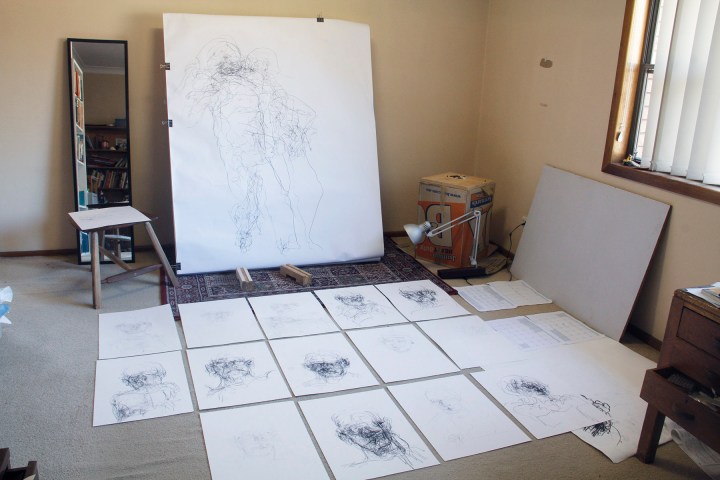 The inside drawing studio with recent works. I will be making a lot of work out in the workshop-studio, however having an inside room with a lot of space will allow me to work on multiple projects concurrently. I am planning on doing a series of large scale drawings at life-size, one of which is on the drawing board at the back. These works will be a continuation and extension of the blind proprioceptive experiments I have been working on.
The inside drawing studio with recent works. I will be making a lot of work out in the workshop-studio, however having an inside room with a lot of space will allow me to work on multiple projects concurrently. I am planning on doing a series of large scale drawings at life-size, one of which is on the drawing board at the back. These works will be a continuation and extension of the blind proprioceptive experiments I have been working on.

















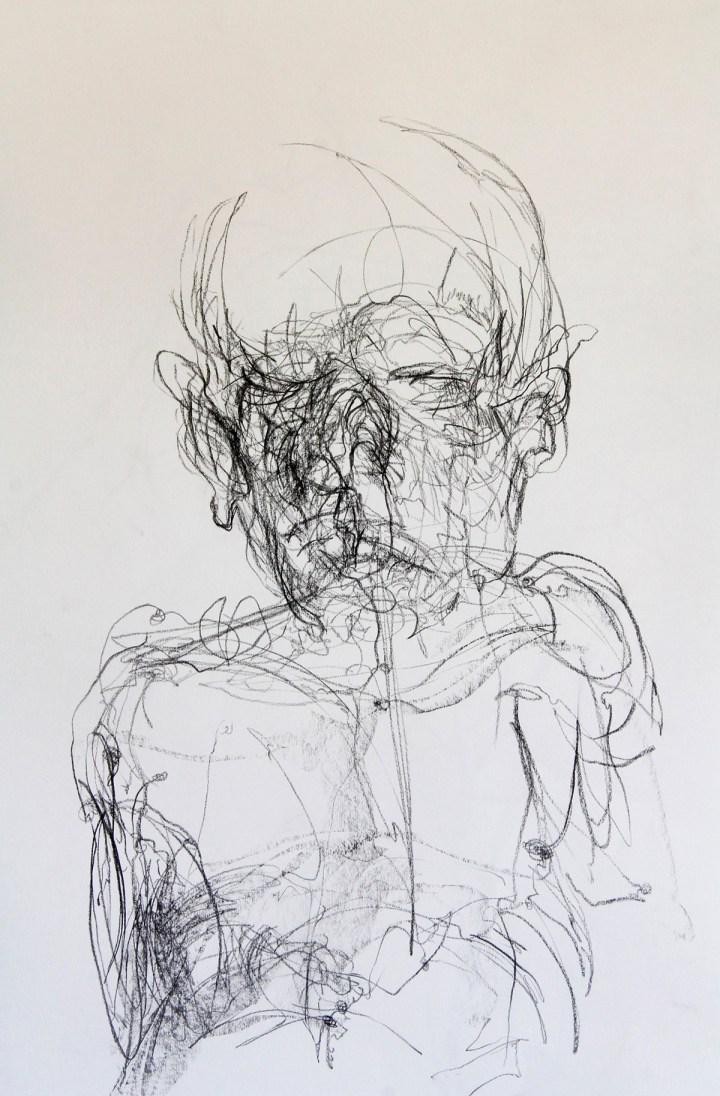





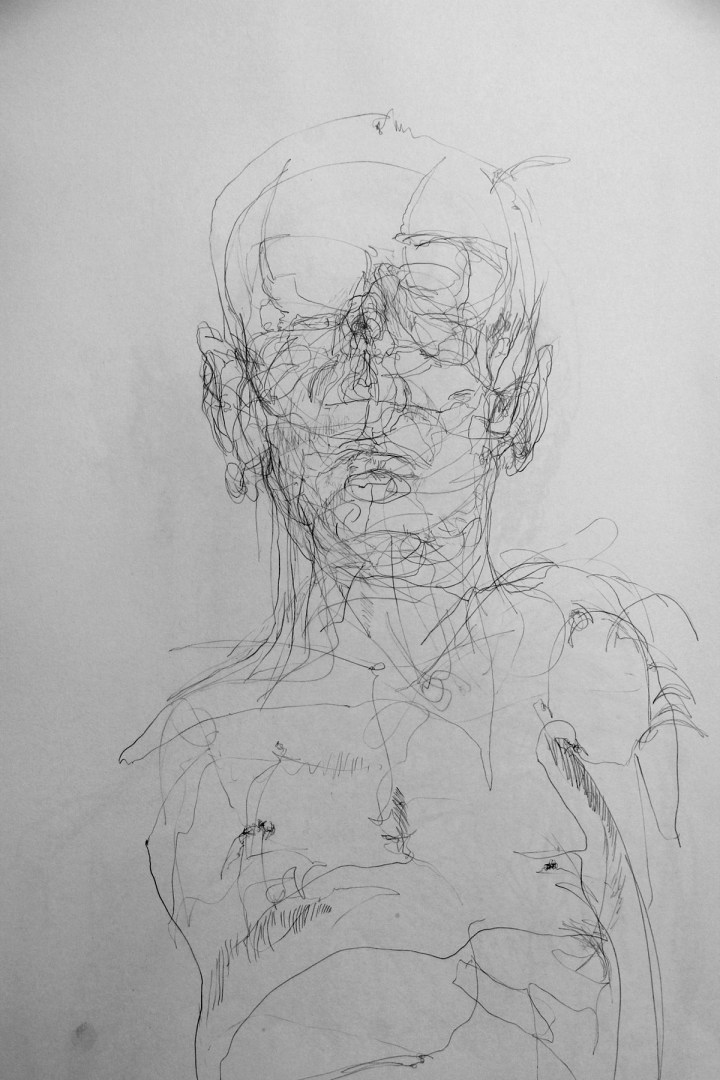
Life Drawing
These are a series of proprioceptive life drawings, while wearing a blindfold I hold a pose and map out my body. I draw following a similar format to conventional life drawing sessions, the poses are between 3 and 5 minutes long.








Drawings from recent life drawing sessions.








Thinking Drawings
This is a selection of thinking-drawings from my notebooks. They are a means to very quickly simulate, record, and test ideas for planned works. When planning out works there is a process of imagination and/or simulation; whether designing a chair or proposing an arrangement for a drawing/sculpture experiment I am internally acting out the process of making. The drawing is an active part of the thinking through of the propositions, as well as serving as a record of the process of thinking as well as the idea itself. The pencil and paper become an external memory system.

^I have been drawing this proposed chair repeatedly, I find it easiest to plan and simulate the sitting-in and making-off the chair when I am sitting in a similar chair. So rather than looking at a chair in profile I am drawing myself from an external perspective, relying on my proprioceptive and tactile awareness, my understanding of the chair (and of what chairs are), my learned familiarity with the anatomy of chairs and the body, and my learned and practiced skill in mimetic representation.
In addition to the proposition of the function of the chair there is also the simulation of the making of the chair, what wood I have access to, how the tools will shape the wood, how the wood will respond to the tools, and so on. Before I even pick up a plane it is there as an extension of my body.
Although at first glance this sketching process may align itself more with design practice methods, I am using it as a launching pad for the consideration of drawing and making as extensions of the body. This process will also serve to plan the apparatus that I intend to make to facilitate more complex arrangements of drawing and sculpting projects.
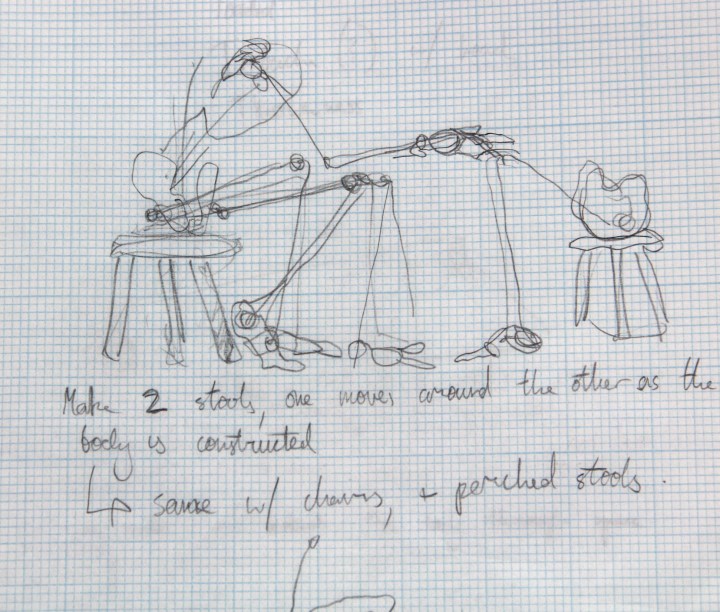




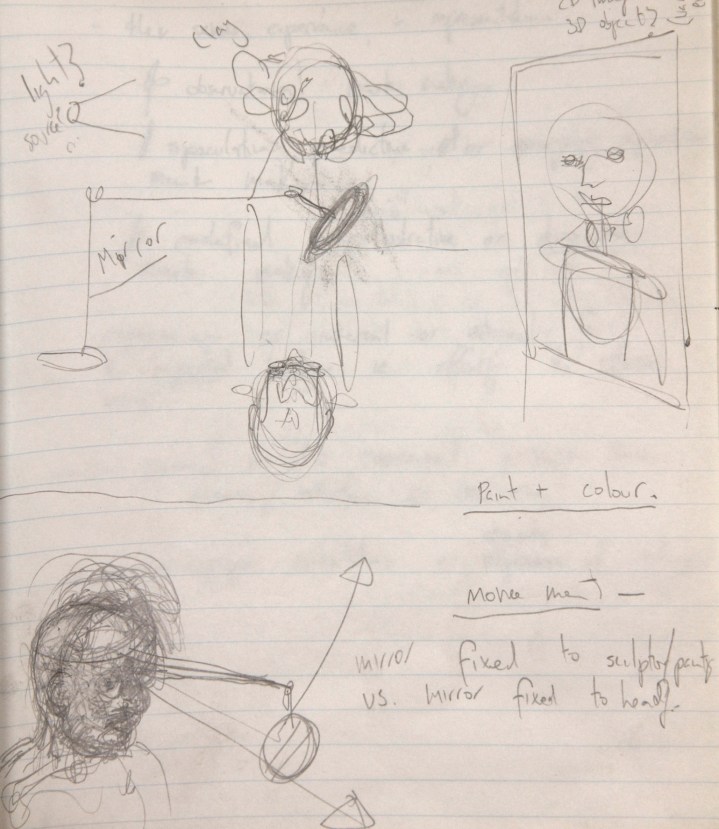
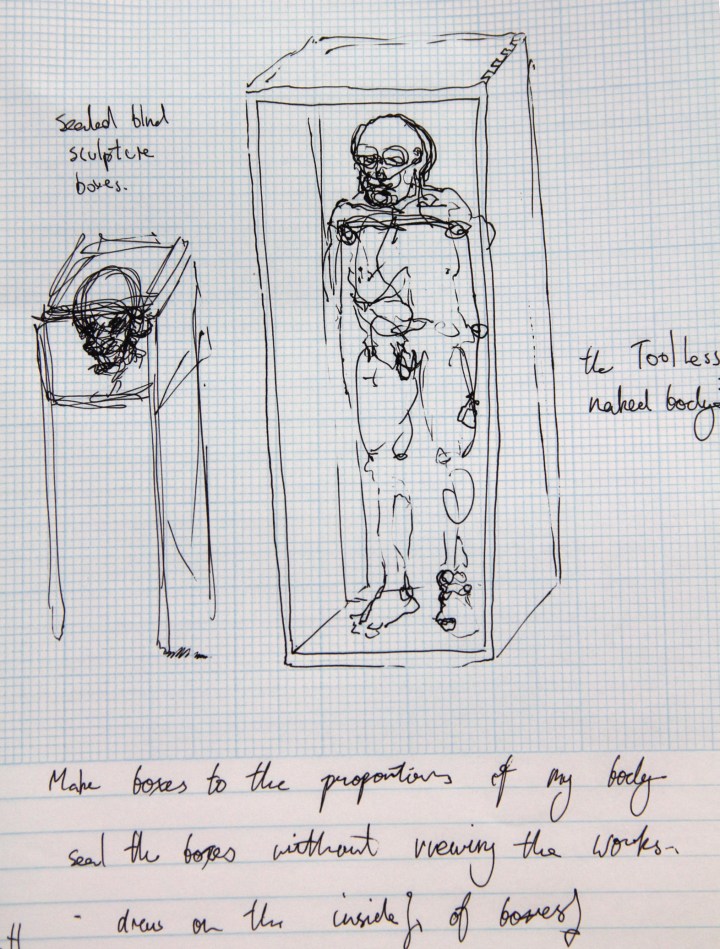



Heads, Bodies, and Furniture – Progress
These are some drawings and process shots from my ongoing drawing experiments. I’m beginning to expand the drawings to include a larger network of objects and perceptual information. In the first two images the drawing is a tactile and proprioceptive drawing of myself and the bust. Soon I will be developing the sculptural work further, beginning with blind proprioceptive and tactile representations of my own body, similar to the two vague forms to the left and right of the central bust in this drawing, and to the blind proprioceptive drawing below.



^ This third drawing is done entirely through proprioception, mapping out the body through my awareness of position in space, I do not need to fondle my face or the chair to know where they are or how to draw them. There are two interwoven factors here, one is my awareness and memory of the shape and position of the objects at hand—although i am only touching the chair in a few places (the seat, footrests). The second is my practiced skill at representing these objects with more familiar methods, having drawn countless bodies and chairs.
I am still working on the sculpted wooden bust. I have been going back and forth between drawing on the bust while blindfolded, again relying on my familiarity and awareness of my head and face. I then use these marks as a guide as to what material to remove, which is problematic in that I am influenced by my desire to make the bust mimetically accurate, rather than faithfully follow the marks. Ultimately the work being done ends up as a compromise between these two elements.



I have a few reservations about this work, the process is clunky, labour intensive, and time consuming, and the pine is quite soft and bruises easily. Working with harder timber, and starting with a blank closer to the final proportions of the body may help, but will also require a dramatic overhaul of process, and will require a fair bit of machining and powertooling to achieve.

—

Finally, I have been considering the role of workshop and studio furniture in my practice. As the drawing and sculptural aspects of the work develop they are beginning to expand to include consideration and depiction of the props and apparatus involved in the process: the ground, benches, plinths, chairs, drawing boards etc. For example, in the blind proprioceptive drawing of myself sitting in the chair (above) a lot of my understanding of the form of the chair comes from designing the chair I have been working on (shown here). As such I have been designing and constructing my own studio and workshop furniture. Initially these are following fairly familiar forms, but as the project progresses I plan on introducing new structures to facilitate different arrangements and relationships between myself, subjects, drawing surfaces, working sculptures, and collaborators.



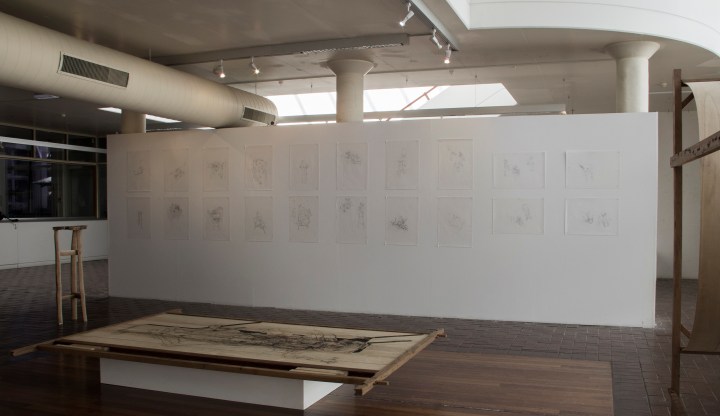

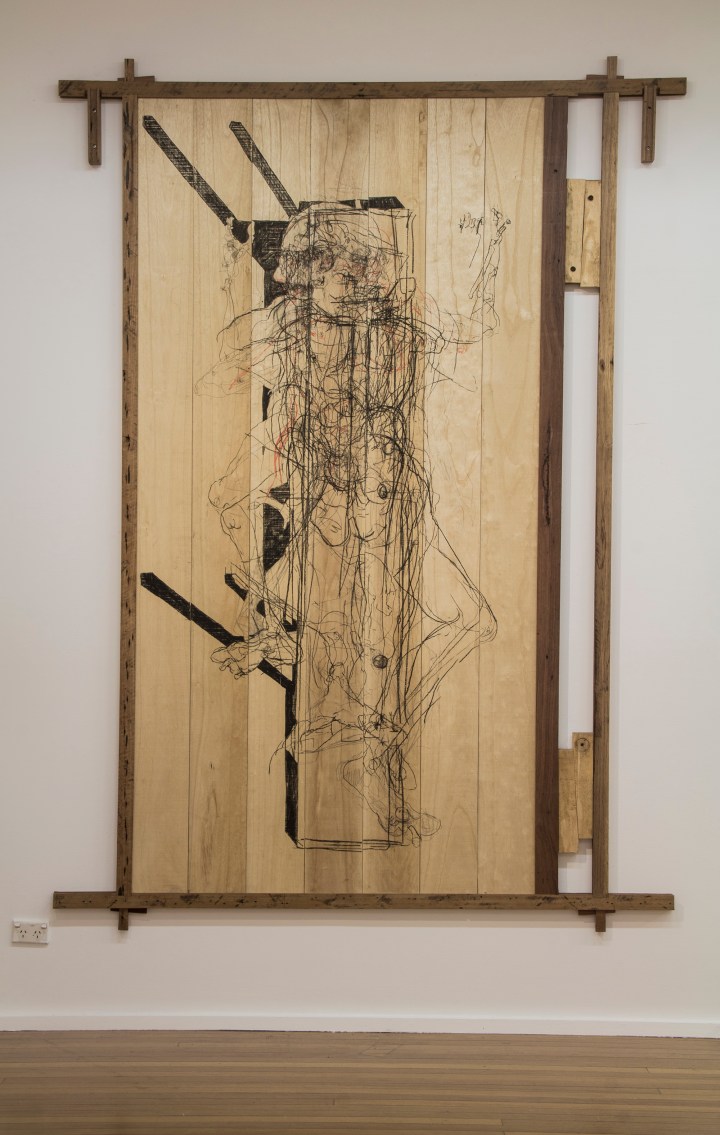

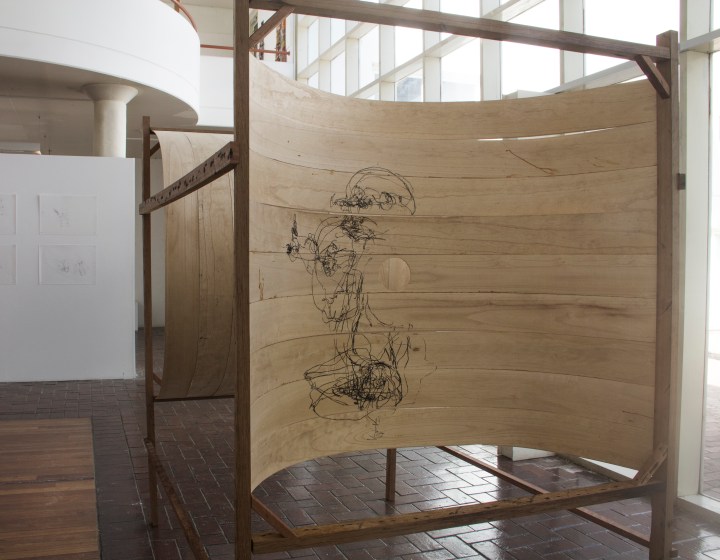






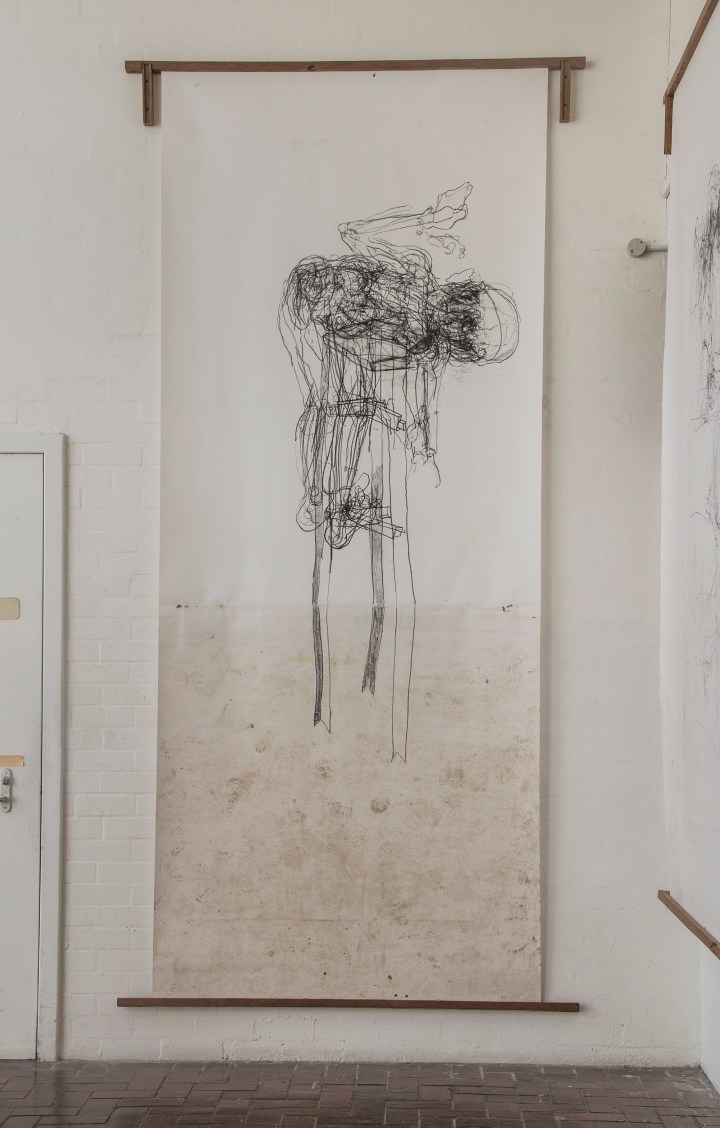





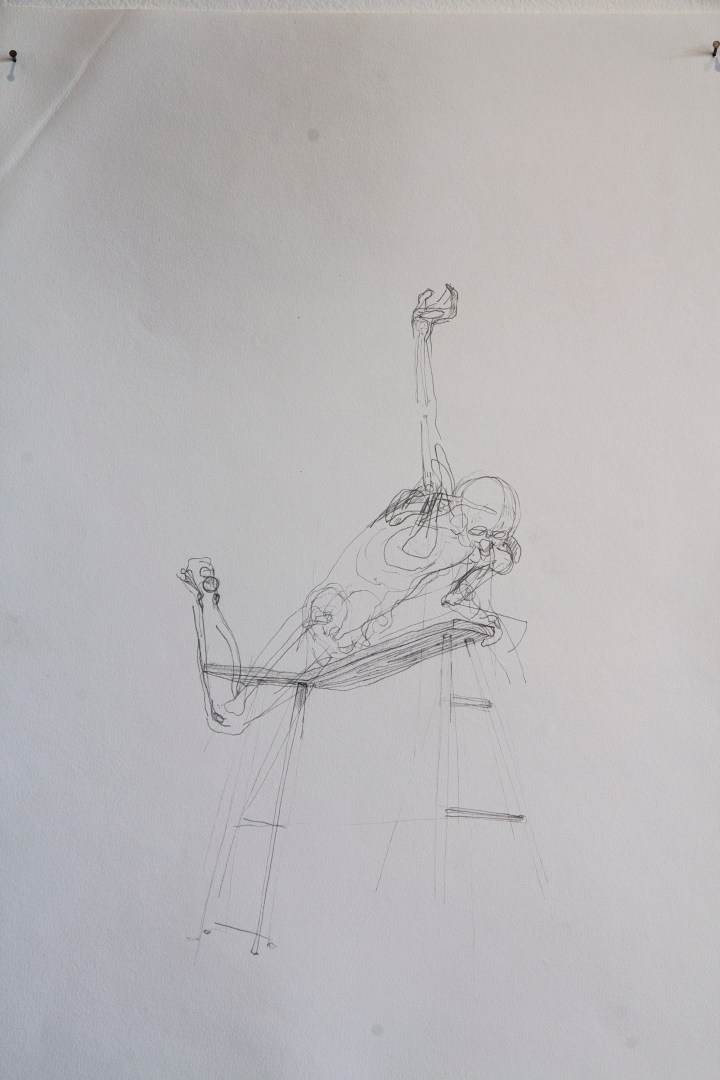


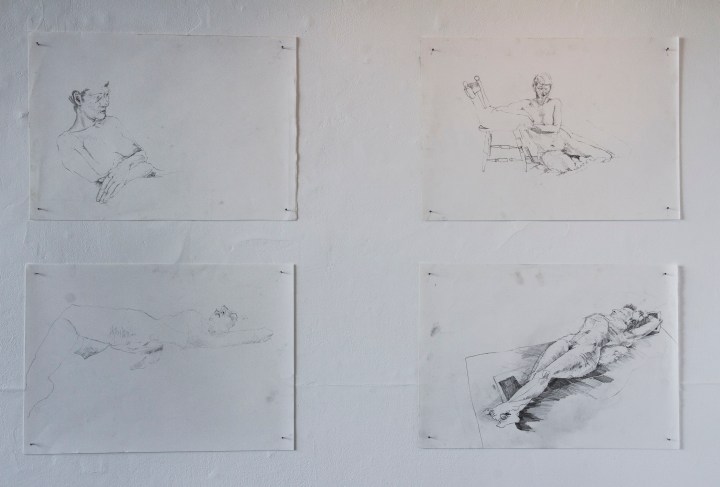









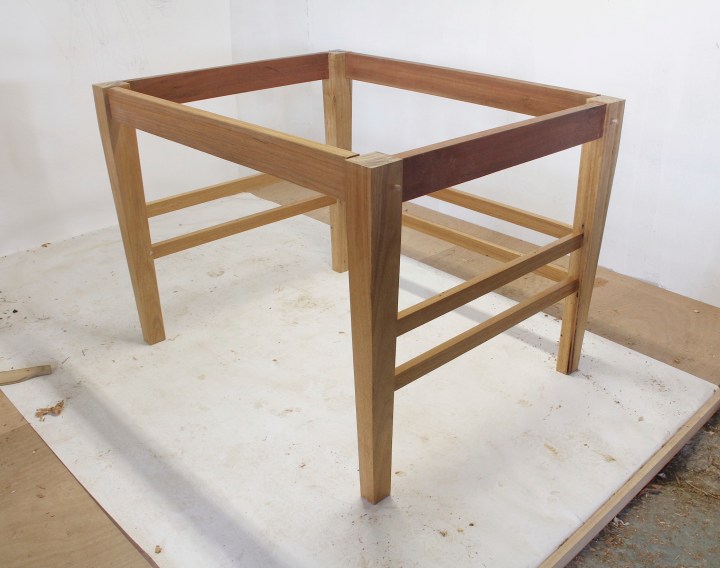





1 comment